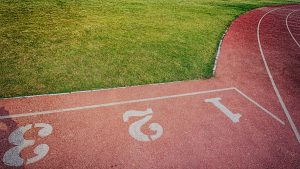
Track and field is an athletic Olympic sport which includes contests in running, jumping and throwing. It is one of the oldest sports in history, dating back to ancient Olympic games held in Greece in 776 B.C. The sport derives its name from the stadium it typically takes place in: an oval running track enclosing a grass field.
In the foot racing events, including sprints, middle- and long-distance events, race walking and hurdling, the winner is the athlete with the fastest time. Sprints are short distance races, ranging from 100m to 500m (109.3yd to 546.8yd). The middle-distance events range from 800 to 2,000 m (874.4 to 2,187.2 yd) and the most popular of them all is the mile (1.6km race). Unlike sprints, where the inherent speed of the competitors ultimately decides the winner, in longer distance races endurance and strategy have a much more important role to play. In hurdling, athletes must possess the speed of a sprinter and the ability to clear 10 hurdles of 42in for men, or 8 hurdles of 33in for women.

In the jumping and throwing events, the greatest distance or height decides the winner. The list of the most common jumping events includes long jump, triple jump, high jump and pole vault.
As for the throwing events, the most popular are shot put, javelin, discus and hammer. These differ with respect to objects being thrown. Shot put uses a heavy sphere, usually made of steel weighing 7.260 kilograms (16.01 lb) for men, and 4 kilograms (8.8 lb) for women. Javelin is spear about 2.5 m (8 ft 2 in) in length. Discus is a platelike object weighing 2 kg (4 lb) for men and 1 kg (2 lb) for women. Finally, a hammer is a metal ball attached by a steel wire to a grip. The ball weighs 16 pounds (7.26 kg) for men and 8.82 lb (4 kg) for women.
There is also plenty of combined events, where athletes compete in a number of track and field events. These include decathlon (consisting of 10 events), heptathlon (consisting of 7 events) and pentathlon (consisting of 5 events).








